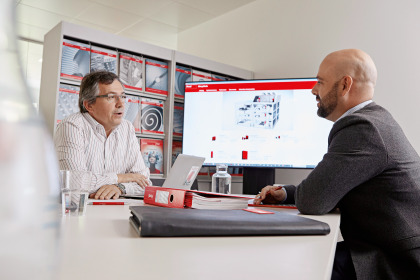High heating capacity, precisely adapted to demand
.jpg)
High heating capacity, precisely adapted to demand
The ecclesiastical and secular men who once built St. Peter's Basilica and the other buildings of the Vatican in the middle of Rome were men of grand gestures and monumental visions.
But how, for example, is the Pope's seat, the Palazzo Apostolico, heated? Anyone who suspects a correspondingly huge system is wrong.
It's all about the right size...
Alongside the Vatican's technicians, Hoval experts adapted the system's performance to the actual energy demand. The three previous boilers, each with an output of 5.5 megawatts, are now replaced by three Hoval high-performance industrial boilers with 3 megawatts each. As a result, the output has been reduced by around 45 percent, and so the Vatican is now saving energy – without the Pope having to freeze in his apartments in the Palazzo Apostolico and the people in the surrounding rooms.
... and on the reliable partner
As a qualified and reliable partner, Hoval supplies a whole range of church institutions in Italy and has therefore also been involved in the renovation of the heating plant and the district heating network from 1920 in the Vatican.
High output up to 20 megawatts
Larger buildings such as hotels, schools and hospitals, as well as warehouses and production halls, require a lot of heat. The heat demand of local and district heating networks can also be high. To this end, Hoval offers a variety of technologies for oil, gas and biomass in finely graded performance classes so that each plant can be designed in exactly the right way. A giant – also in terms of economy – is the Titan-3 3-train boiler. In its highest power class, it has an output of up to 20 megawatts.
Keyword cost-effectiveness: Over the service life of a high-performance boiler of realistically calculated twenty years, the operating costs exceed the initial investment by many times. With its high-performance boilers, Hoval is proving that operating costs can be massively reduced: depending on the system, more than six times the original procurement costs can be saved.
 Austria
Austria
 Belgium
Belgium
 Bulgaria
Bulgaria
 Croatia
Croatia
 Czech Republic
Czech Republic
 France
France
 Germany
Germany
 Hungary
Hungary
 Italy
Italy
 Liechtenstein
Liechtenstein
 Luxembourg
Luxembourg
 Poland
Poland
 Romania
Romania
 Russia
Russia
 Slovakia
Slovakia
 Switzerland
Switzerland
 United Kingdom
United Kingdom
 China
China
 Corporate Website
Corporate Website
 Energy recovery
Energy recovery
